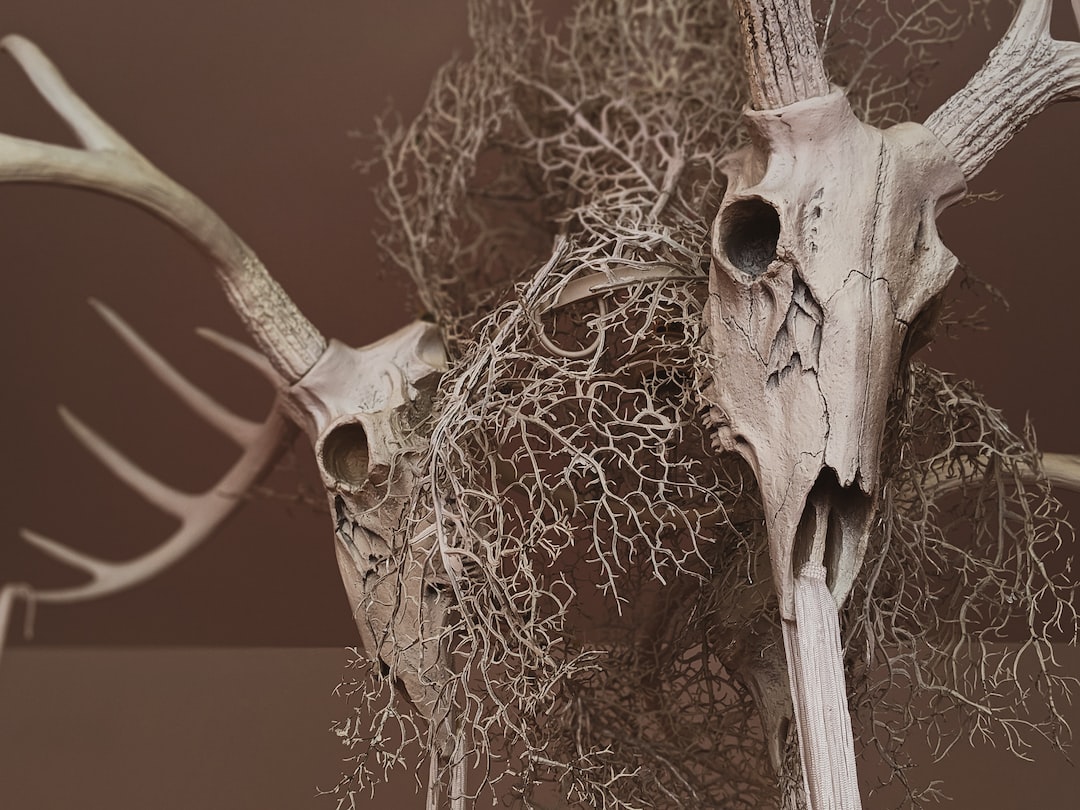Are you looking to add a unique touch of rustic beauty to your home or hunting cabin?
Whitening a deer skull is the perfect way to achieve this. This guide will show you how it’s done, from preparing the skull for whitening all the way through mounting and maintaining your finished euro mount.
No matter your level of expertise, these hints and tips can help you achieve an impressive euro mount with minimal effort. So let’s get started on learning how to whiten a deer skull.
Preparing the Skull
1- Cleaning the Skull
The first step in preparing a deer skull for whitening is to clean it. Clean the deer skull with warm water, dish soap and a soft bristled brush or old toothbrush to get into all crevices where dirt may have accumulated.
Carefully scrub the skull, paying special attention to any crevices or recesses where dirt and other particles may have settled. Rinse off any remaining soap residue before proceeding to the next step.
2- Removing Flesh and Hair
Once the skull is clean, use boiling water and scraping tools to remove any remaining flesh or hair from the bone. This can be done using boiling water, as well as scraping tools like knives or hacksaws for tougher bits of tissue that are harder to remove.
Boiling will also help sanitize the skull by killing any bacteria present on its surface. Make sure you wear gloves when handling boiled skulls.
3- Boiling the Skull
Finally, once all of the flesh has been removed from your deer skull, it’s time for boiling. Place your cleaned and prepped skull into a large pot filled with enough water so that it is completely submerged – this helps ensure even cooking throughout all parts of your trophy piece.
Once the fat has melted away, reduce heat and simmer for between one to four hours (depending on size), then lift out with tongs or gloves. Once finished boiling carefully lift out with tongs or gloves – let cool before proceeding onto finishing touches.
Once the skull has been stripped of all flesh and hair, whitening can begin. To achieve a whitened skull, there are multiple techniques that can be utilized depending on what supplies you have.
4- Whitening the Skull
Various techniques can be employed to whiten the skull of a deer, depending on the desired outcome.
Hydrogen peroxide is an effective whitening agent that can be used to bleach the bones of your trophy buck.
To do this, you’ll need to submerge the skull in a solution of hydrogen peroxide and water for about 24 hours. Once removed from the solution, you should see some lightening of color and bleaching effects on the bone.
Another way to whiten your deer skull is by using a mixture of bleach and water. This method requires more time than using hydrogen peroxide but will give you better results if done correctly.
Begin by mixing one part bleach with four parts warm water in a large container or bucket that’s big enough to fit your entire deer skull into it.
Submerge the skull in the mixture of bleach and warm water for up to two days, then take it out and rinse away any leftovers with icy H2O or wipe off using paper towels. You should notice significant changes after this process is complete.
Finally, there are commercial products available specifically designed for whitening skulls like yours quickly and easily without having to use harsh chemicals or liquids like those mentioned above.
These products typically come as powders or gels that are applied directly onto wet surfaces such as freshly cleaned skulls before being left overnight until they have dried completely – usually taking around 12-24 hours depending on how much product was used initially during application time.
The end result? A beautifully bleached bone surface ready for display.
No matter which method you choose when whitening your deer skull, make sure to take all safety precautions into consideration before beginning any project involving potentially hazardous materials such as those listed here today.
After the bleaching process, it’s time to give your deer skull a professional finish with some extra touches. Sanding and polishing can bring out the best in your deer skull while applying sealant or wax will protect its finish.
Finishing Touches for a Professional Look
Giving your deer skull a professional look is not as difficult as it may seem. With the correct equipment and components, you can fashion a gorgeous exhibit piece that will stand for years. Sanding and polishing are key components of creating a stunning finish on your deer skull.
Begin by using an abrasive to rid the skull of any dirt or other particles. Be sure to use caution when sanding, as too much pressure could damage the bone structure beneath.
Once all the dirt has been taken away, progress to sanding with finer grades of abrasive paper until you have a polished finish. After this step is complete, you can move onto polishing with either steel wool or buffing compound depending on how shiny you would like your finished product to be.
To protect your newly polished deer skull from wear and tear over time, applying sealant or wax is recommended.
Sealants help keep moisture out while also adding shine and luster to the surface of the skull; however they must be reapplied periodically in order for them to remain effective against water damage over time.
Waxes offer more protection than sealants but require more maintenance since they need to be re-applied every few months in order for them stay waterproofed against outdoor elements such as rain or snowfall which can cause discoloration if left untreated long enough.
If done properly these finishing touches should ensure that your deer skull remains looking its best for many years down the road.
For a professional look, sanding and polishing the skull as well as applying sealant or wax to protect the finish will ensure your deer skull looks its best. Moving on from here, it’s time to consider mounting your deer skull for display purposes.
Mounting Your Deer Skull for Display Purposes
Mounting a deer skull for display purposes can be an exciting and rewarding experience. Selecting a technique for mounting a deer skull as an exhibit can be perplexing, so it is essential to comprehend the distinctions between them before settling on one.
When deciding on a mounting approach, think about the expenditure, simplicity of assembly and how much room you have in your dwelling or workplace. Some popular options include European Skull Mounts (ESM), Skull Hookers, and DIY mounts.
ESMs require professional taxidermy work and will cost more than other methods; however they provide a beautiful finished look that is sure to impress visitors.
Skull Hookers are simple yet effective wall mounts designed specifically for displaying animal skulls; they come with everything needed for installation and offer great flexibility in terms of positioning the mount on the wall.
If you’re feeling creative or want to save money, then DIY mounts may be right up your alley – these involve using basic materials like wood or metal rods which can be found at most hardware stores.
Once you have chosen a mounting method, it is time to prepare your deer skull for installation. This process typically involves cleaning off any dirt or debris from the surface of the skull using warm water and mild soap before bleaching it with hydrogen peroxide until it reaches the desired whiteness level – be sure to wear gloves when handling bleach.
You may also need to remove any antlers attached to smaller skulls if necessary; this can easily be done by cutting through the connective tissue holding them in place with scissors or wire cutters.
After finishing up with the bleaching process, let dry completely before beginning actual install procedure following instructions provided by manufacturer if applicable depending on type of mount chosen earlier prior starting project – good luck.
Mounting your deer skull for display purposes is a great way to preserve the beauty of nature and honor the animal. For optimal preservation of your deer skull, regular upkeep is essential. To keep your mount in top condition, make sure to follow these tips on maintaining it properly.
Maintenance Tips for Long-Lasting Results
To ensure your deer skull stays looking its best for years to come, proper maintenance is key. To ensure your deer skull remains in optimal condition, here are some maintenance tips to follow.
Avoid Exposing Your Deer Skull to Moisture:
When it comes to preserving a deer skull, moisture is the enemy. To ensure the longevity of your mount, store it in a dry area and protect it from direct sunlight with waterproof covering when not on display. If you’re displaying outdoors, consider covering it with a waterproof tarp or plastic sheeting when not in use.
You should also avoid cleaning with water or other liquids as they can cause discoloration and weaken the antlers over time.
Regularly Check for Signs of Deterioration:
Over time, even if stored properly, natural wear and tear can occur due to age or environmental conditions like extreme temperatures or UV rays from the sun.
It’s important that you check your mount regularly for signs of deterioration such as cracking or fading so that any necessary repairs can be made quickly before more extensive damage occurs.
Storing your deer skull in a low humidity area when not in use is essential for preserving its appearance and structural integrity over time.
Keeping it indoors where possible, such as an air conditioned room or closet space with consistent temperatures, will help ensure that there isn’t much fluctuation between hot and cold weather extremes outside.
This way you can enjoy showing off the beauty of your mount for many years to come without worrying about mold or mildew buildup or irreversible damage due to age or environmental conditions like UV rays from the sun.
FAQs in Relation to How to Whiten a Deer Skull
What is the best way to whiten a deer skull?
The best way to whiten a deer skull is through the use of dermestid beetles. This method involves placing the skull in an airtight container with the beetles, which feed on organic material and clean away any remaining tissue or fat from the bone.
The length of the process depends on skull size and density, yet when completed correctly a long-lasting white finish is achieved.
Will 3 peroxide whiten a skull?
Yes, 3% hydrogen peroxide can be used to whiten a skull. Using hydrogen peroxide at a 3% concentration can be an effective means of cleaning and brightening the bone surface, yet caution should be taken when applying any chemical to bones as some may cause harm if not used correctly. When done correctly, this process will result in a clean white finish that looks like new.
However, care must be taken when using any chemical on bones as some may cause damage or harm if not handled properly.
Can you whiten a deer skull with bleach?
Yes, you can whiten a deer skull with bleach. The procedure is quite uncomplicated and necessitates immersing the skull in a weakened bleach mixture for some hours or days depending on how white you wish it to be.
You should wear protective gear when handling the bleach solution as it can cause skin irritation and damage clothing. After removing from the solution, rinse thoroughly with water and allow to dry completely before displaying or storing your newly whitened deer skull.
How long do you leave bones in hydrogen peroxide?
Hydrogen peroxide is a powerful oxidizing agent and can be used to clean bones. Nevertheless, it should be handled with care since prolonged contact can detrimentally affect the bone’s composition.
For more effective cleaning, hydrogen peroxide should be left on the bone for no longer than 10-15 minutes at a time and repeated up to three times with an overall exposure limit of 45 minutes. If you need more cleaning power, you can repeat this process up to three times but no longer than 45 minutes total of exposure time is recommended.
Conclusion
Now that you know how to whiten a deer skull, it’s time to take the next step and show off your trophy. With proper preparation and maintenance, you can ensure that your euro mount will last for years.
Once you have completed the whitening process, your trophy will be ready to showcase – a source of pride that can last for years with proper care.
Whitening a deer skull is an art form – one that requires patience and attention to detail. But with some practice, anyone can achieve professional-looking results every time they attempt this rewarding task.



